Facilities teams need to deal maintenance requests, vendor contracts, and space planning with disconnected tools…making it nearly impossible to get ahead.
The right facilities management software shifts you from reactive firefighting to proactive optimization. monday service unifies these efforts into one connected platform.
This guide covers the essential features, key benefits, and top solutions for 2025. We’ll also explore how AI is revolutionizing facility operations and share a clear 5-step implementation plan.
Try monday serviceWhat is facilities management software
Facilities management software acts as the central nervous system for your buildings, converting chaotic spreadsheets and disconnected requests into a single, streamlined workflow. This empowers your team to shift from reacting to problems to preventing them, enhancing both efficiency and strategic oversight.
This technology bridges the gap between physical spaces and operational objectives, ensuring every component functions with precision. It monitors equipment health, schedules routine upkeep, and oversees maintenance requests from start to finish.
True operational alignment happens when facilities management integrates flawlessly with the entire organization.
A platform like monday Service dismantles departmental silos, enabling collaborative problem-solving. When a request requires input from IT or HR, all stakeholders can converge in one digital space to deliver an exceptional service experience.
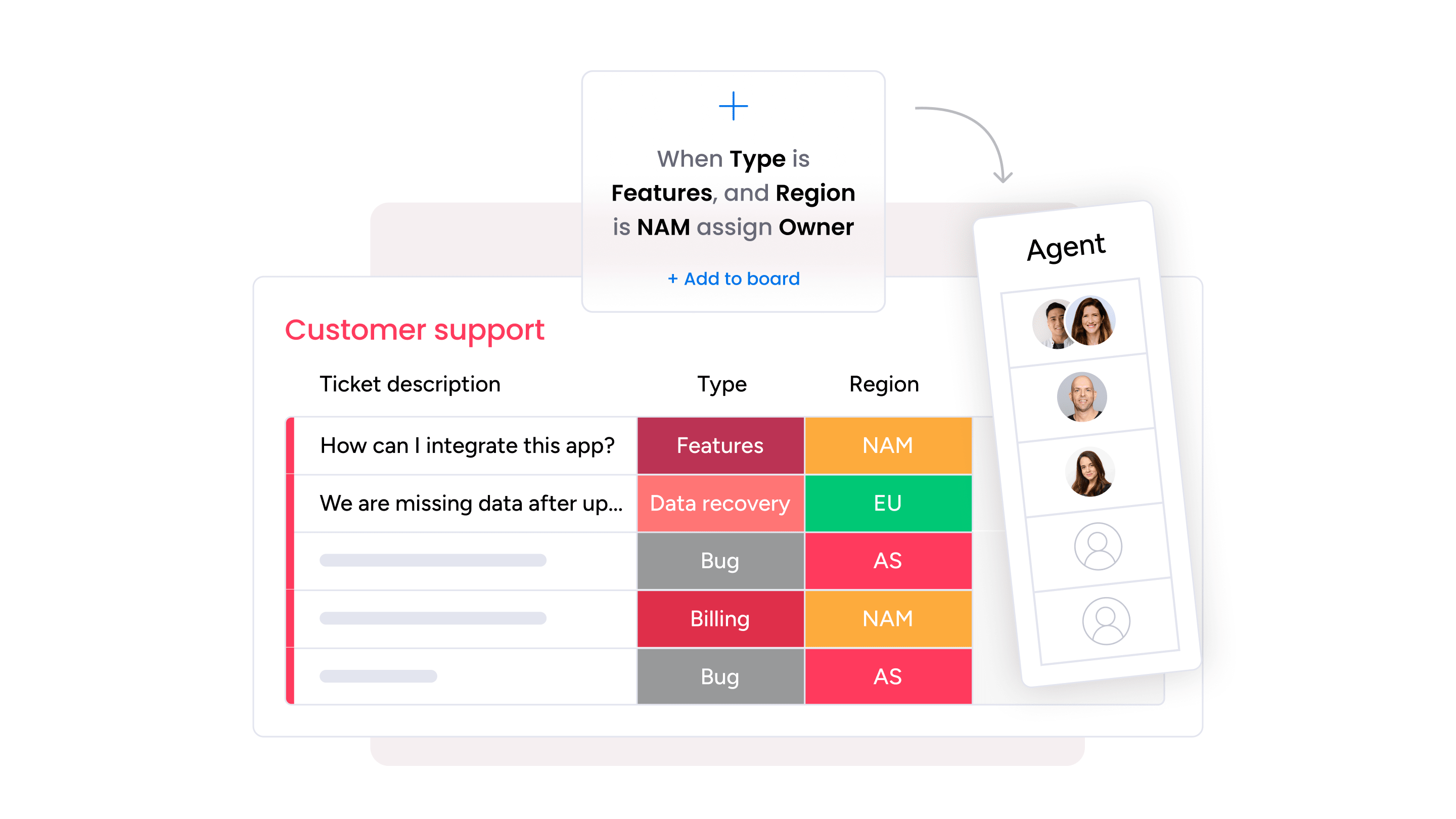
Key benefits of facility management platforms
Transform reactive operations into strategic assets
A complex facility management platform empowers you to get ahead of issues, turning routine maintenance into an opportunity to optimize every piece of equipment and square foot of space you manage. Your physical assets should be actively contributing to your success.
Centralize operations in a single, visual workspace
Your team can manage everything from work orders to preventive maintenance schedules with complete clarity. This central hub connects people and data, ensuring that information flows seamlessly from the initial request to the final resolution without anything getting lost in translation.
Reduce costs and break down information silos
The results are tangible: teams can dramatically reduce maintenance costs and extend the lifespan of their equipment. With a platform like monday Service, the advantage is amplified by connecting facility operations directly to the rest of the business. This approach provides total visibility, breaking down the information silos that other platforms were not designed to address.
Try monday serviceTypes of facility management solutions
Choosing the right facility management platform shouldn’t add complexity: it should cut through it. The goal isn’t to master a maze of acronyms or juggle multiple specialized tools. Instead, you need one flexible workspace that molds to how your team actually works and scales as your organization grows.
Your facility needs are unique. Maybe you’re focused on keeping operations running smoothly with preventive maintenance, or perhaps you’re orchestrating complex space planning and resource allocation across multiple sites. monday Service brings all these moving parts into one visual, intuitive platform. No more switching between disconnected systems just to understand what’s happening across your facilities.
When your entire team works from the same platform, collaboration becomes effortless. Technicians get instant updates on their mobile devices, stakeholders track progress in real-time, and managers access the insights they need to make smarter decisions on the fly. This creates a connected operation where everyone has the context and tools to solve problems faster and more effectively.
Must-have features in facilities management software
The right facilities management software transforms how your team operates. Instead of reacting to problems as they arise, you’ll have the tools to anticipate needs, optimize resources, and deliver an exceptional workplace experience. Here are the essential features that separate basic task managers from true operational command centers.
- Work order management: Capture, assign, and track maintenance requests from submission to completion with full visibility into status, priority, and resolution time
- Preventive maintenance scheduling: Automate routine maintenance tasks based on time intervals or usage metrics to prevent equipment failures before they disrupt operations
- Asset tracking and lifecycle management: Monitor equipment health, maintenance history, and warranty information to maximize asset lifespan and make informed replacement decisions
- AI-powered predictive capabilities: Artificial intelligence is rapidly becoming an indispensable partner for facilities teams, helping to convert reactive fire drills into a proactive strategy that provides foresight. With monday Service, this predictive power is integrated directly into the platform to anticipate your team’s needs.
- Mobile accessibility: Enable technicians to receive assignments, update work orders, and access asset information directly from the field without returning to a desk
- Real-time analytics and reporting: Access performance dashboards that reveal trends in maintenance costs, response times, and resource utilization to drive smarter decisions
- Space management: Optimize facility layouts, track occupancy, and manage desk reservations to ensure your physical spaces align with how teams actually work
- Vendor and contract management: Centralize vendor information, track service agreements, and manage external maintenance relationships in one organized system
- Self-service portals: Empower employees to submit requests, check ticket status, and access knowledge bases without creating bottlenecks for your facilities team
- Integration capabilities: Connect seamlessly with your existing tech stack – from communication tools to financial systems – to create a single source of truth across your organization. monday Service excels in this role, acting as the ultimate connector for your entire tech stack.
Top 5 facilities management software solutions
1. monday service
monday service transforms how organizations handle facility requests through AI-powered automation and intuitive workflow design. The platform connects facility management with broader organizational workflows, making it ideal for teams managing everything from maintenance requests to space planning across complex buildings and campuses.
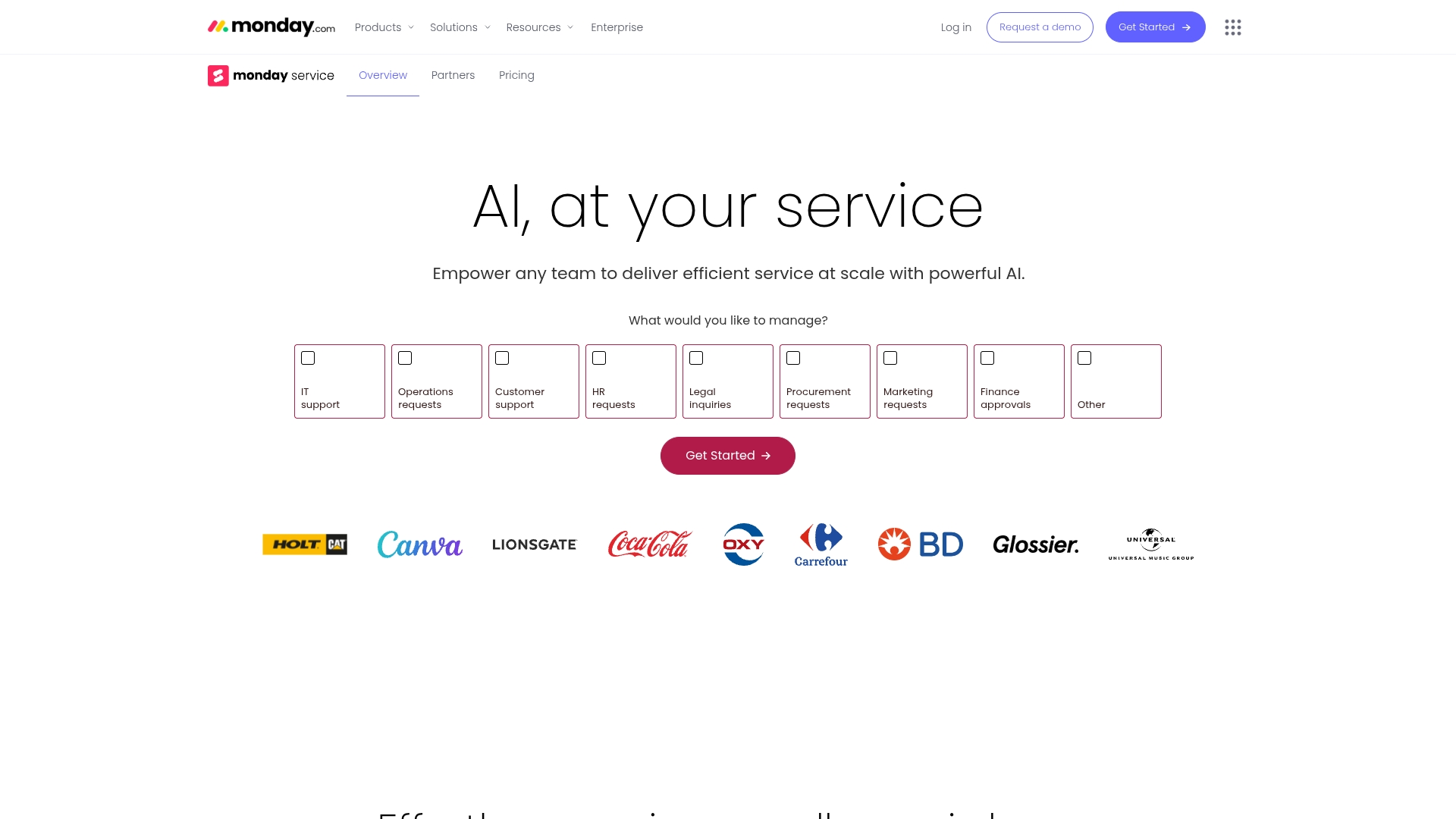
Example:
monday service provides a centralized platform for facilities teams to organize, track, and automate their work while moving from reactive problem-solving to proactive, data-driven facility management.
Key features:
- Centralized ticket management — Capture, assign, and track all facility service requests in one intuitive system that prevents tasks from slipping through the cracks
- AI-powered automation — Automatically sort, prioritize, and route incoming tickets to appropriate technicians while using predictive maintenance to anticipate equipment failures
- Customizable workflows and dashboards — Build custom processes using drag-and-drop interfaces for maintenance approvals, safety checks, and vendor management with real-time performance monitoring
Pricing:
- Free: $0 forever (up to 2 seats)
- Basic: $9/month per seat (billed annually)
- Standard: $12/month per seat (billed annually)
- Pro: $19/month per seat (billed annually)
- Enterprise: Contact sales for pricing
- Minimum of 3 users required for paid plans
- 18% discount available with annual billing
Why it stands out:
- No-code customization — Build complex facility workflows without technical expertise, adapting the platform to match your unique operational needs
- Cross-departmental collaboration — Connect maintenance, cleaning, admin, and external vendors in shared workflows that keep everyone aligned on priorities
- Intelligent automation — AI handles routine tasks like ticket routing and status updates, freeing your team to focus on strategic facility improvements
Advanced AI features:
- Smart ticket classification — AI automatically categorizes incoming requests by urgency, issue type, and sentiment to ensure proper prioritization and faster response times
- Predictive maintenance insights — Analyze historical data patterns to anticipate equipment failures and schedule proactive maintenance before costly breakdowns occur
- AI-powered knowledge base — Searchable library of FAQs, guides, and manuals helps teams resolve common facility issues efficiently without escalation
Automations:
- Automated task assignment — Route service tickets to the right department or technician based on predefined rules, eliminating manual sorting and improving response times
- SLA tracking and reminders — Automatically monitor service level agreements with real-time alerts and reminders to ensure timely completion of maintenance tasks
- Custom workflow triggers — Set up automated actions for recurring processes like preventive maintenance schedules, safety inspections, and vendor coordination
Integrations:
- Communication platforms — Connect with Slack, Gmail, Outlook, and Zoom to keep facility updates flowing seamlessly across your existing communication channels
- Document management — Integrate with DocuSign for maintenance contracts and approvals, ensuring proper documentation for compliance and vendor management
- Enterprise connectivity — API access enables custom integrations with building management systems, asset tracking tools, and other specialized facility software
Facilities management software features:
- Asset and equipment tracking — Monitor equipment status, schedule maintenance, and manage staff availability to prevent scheduling conflicts and optimize resource allocation
- Self-service portals — Enable employees and tenants to submit requests, access knowledge bases, and track ticket status through customizable portals that reduce administrative burden
- Compliance monitoring — Track safety regulations, maintenance certifications, and audit requirements with automated reporting to ensure facility standards are consistently met
2. ServiceNow Facility Management
ServiceNow transforms workplace operations through its comprehensive Workplace Service Delivery suite, designed to streamline facilities management for large enterprises. The platform excels at integrating complex approval workflows and managing extensive facility portfolios, making it ideal for organizations seeking unified service delivery across multiple departments.
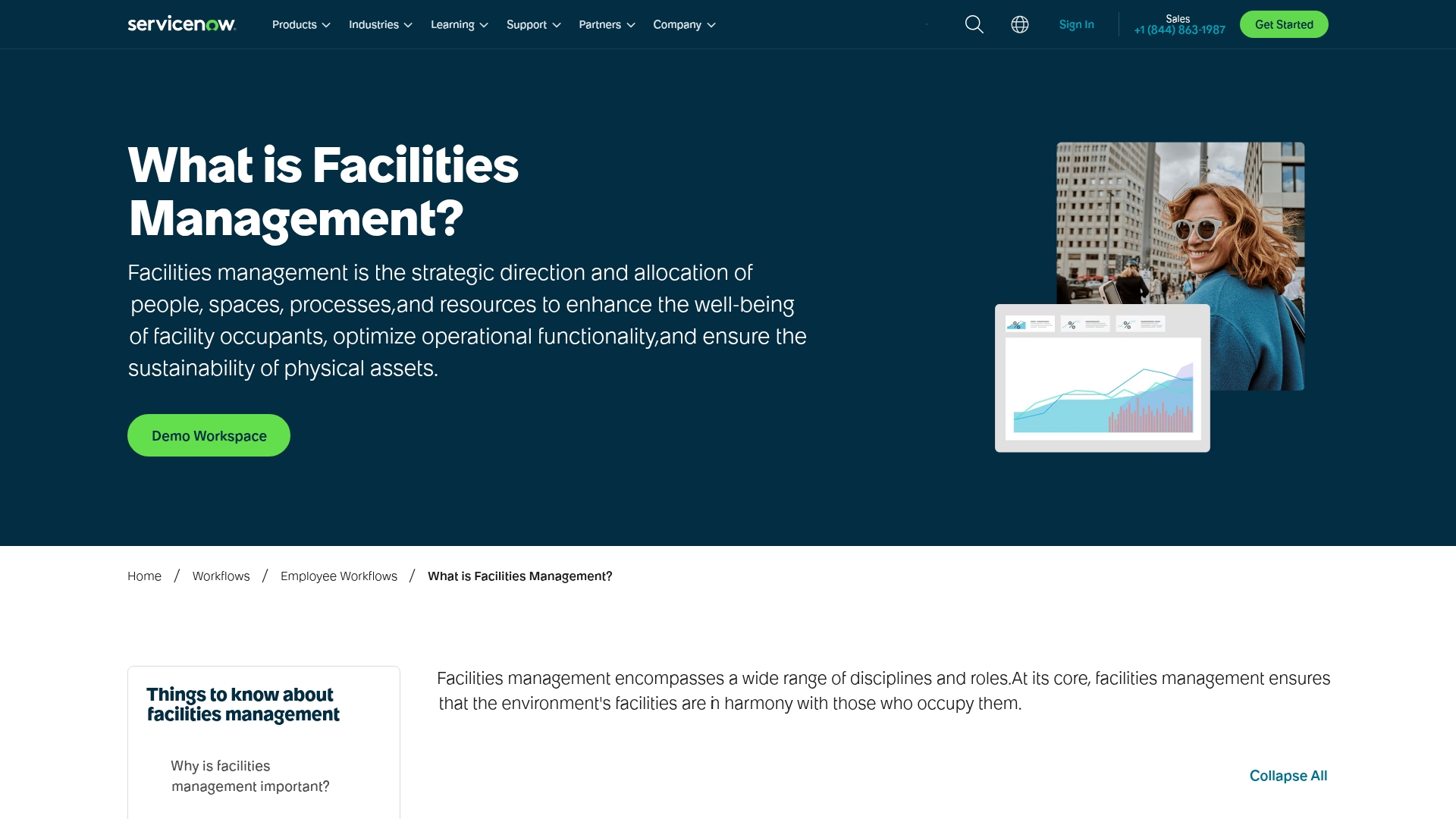
Use case:
ServiceNow’s Workplace Service Delivery provides a unified platform that connects facilities management with IT, HR, and finance operations, enabling seamless cross-departmental workflows and data-driven decision making for enterprise-level organizations.
Key features:
- Space management and optimization: Plan, optimize, and report on space usage with real-time analytics and interactive 3D indoor mapping for easy navigation
- Automated maintenance workflows: Create and manage preventive and corrective maintenance plans across multiple locations with intelligent work order routing
- Employee experience portal: Deliver consumer-grade self-service capabilities for desk reservations, meeting room bookings, and service requests through mobile-friendly interfaces
Pricing:
ServiceNow uses custom pricing based on individual organizational needs and requirements. Contact ServiceNow directly for personalized quotes that scale with your business growth and specific facility management requirements.
Considerations:
- High implementation costs: The platform requires significant investment in both licensing and implementation, often necessitating dedicated internal teams or external consultants
- Steep learning curve: Users report complexity in mastering the platform’s configuration and customization, which often requires specialized JavaScript knowledge for advanced features
3. IBM TRIRIGA
IBM TRIRIGA delivers comprehensive integrated workplace management system (IWMS) capabilities that transform how large enterprises manage their real estate portfolios and facilities operations. The platform specializes in AI-driven space optimization and predictive analytics, making it ideal for Fortune 100 companies and government agencies with complex, distributed real estate assets.
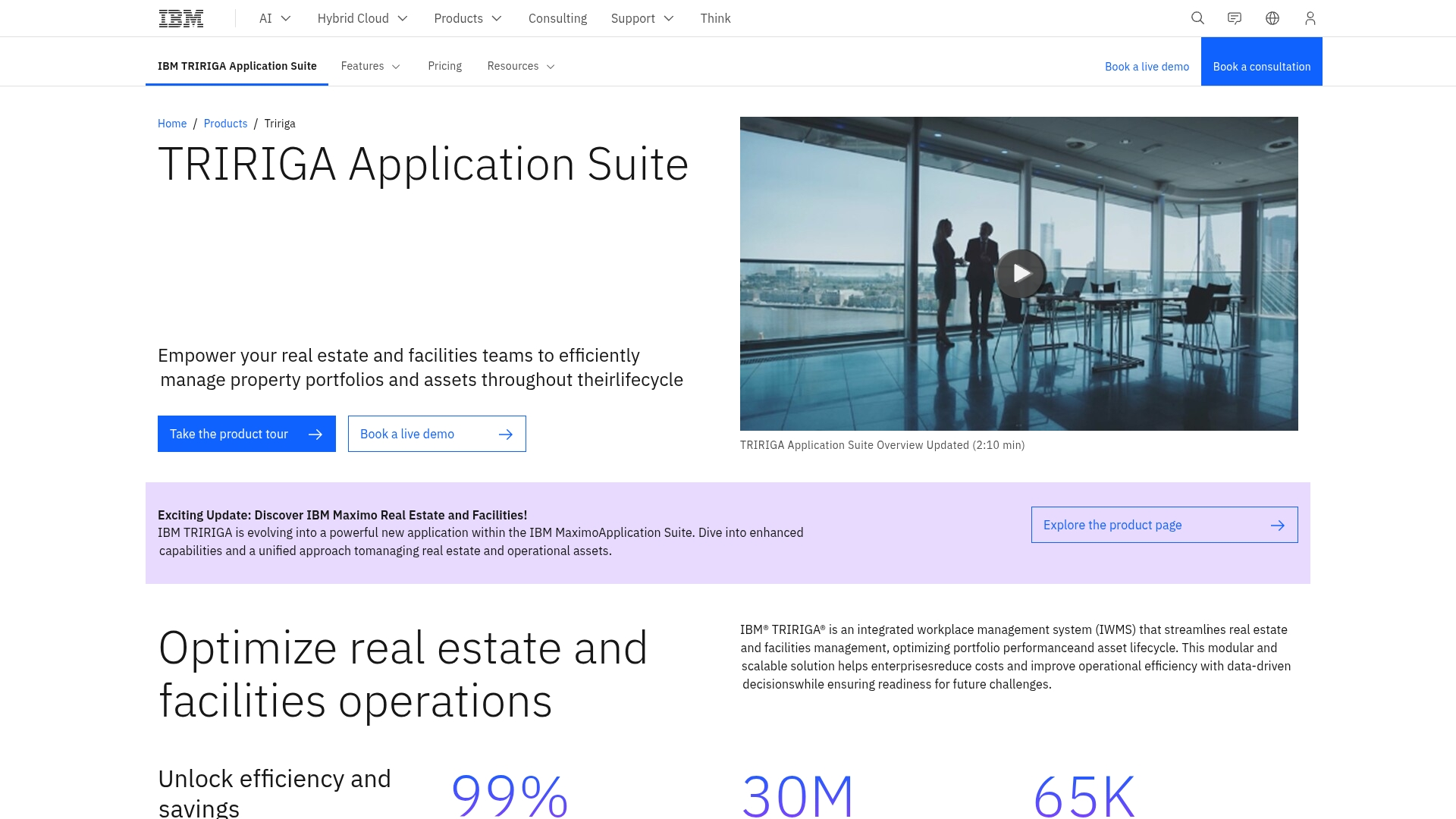
Use case:
IBM TRIRIGA serves as a single source of truth for managing corporate real estate and facilities, leveraging IoT data and AI to optimize space utilization, enhance occupant experience, and control operational costs while supporting business resiliency.
Key features:
- AI-powered space optimization: Real-time occupancy monitoring using IoT sensors, WiFi, and badge data to provide strategic insights for space planning and utilization across entire portfolios
- Comprehensive maintenance management: Automated workflows for both preventive and corrective maintenance with condition-based strategies that predict needs and reduce unplanned downtime
- Capital project lifecycle management: End-to-end tools for managing budgeting, planning, and execution of capital projects to ensure on-time, on-budget delivery
Pricing:
Pricing information is not publicly available and requires contacting IBM sales directly for custom enterprise quotes.
Considerations:
- Complex implementation: The comprehensive nature of the platform can lead to lengthy, complex implementations requiring significant investment in data gathering and process alignment
- Steep learning curve: Users consistently report that the interface can be cumbersome and not intuitive, with substantial training required for new team members
4. MRI Software
MRI Software delivers comprehensive facilities management through its extensible Integrated Workplace Management System (IWMS), combining deep property management expertise with cutting-edge technology. The platform shines with its “open and connected” ecosystem approach, allowing its FM tools to integrate seamlessly with other modules like lease and financial management. This makes it a great fit for large enterprises managing complex, multi-property portfolios who need flexible, all-in-one capabilities.
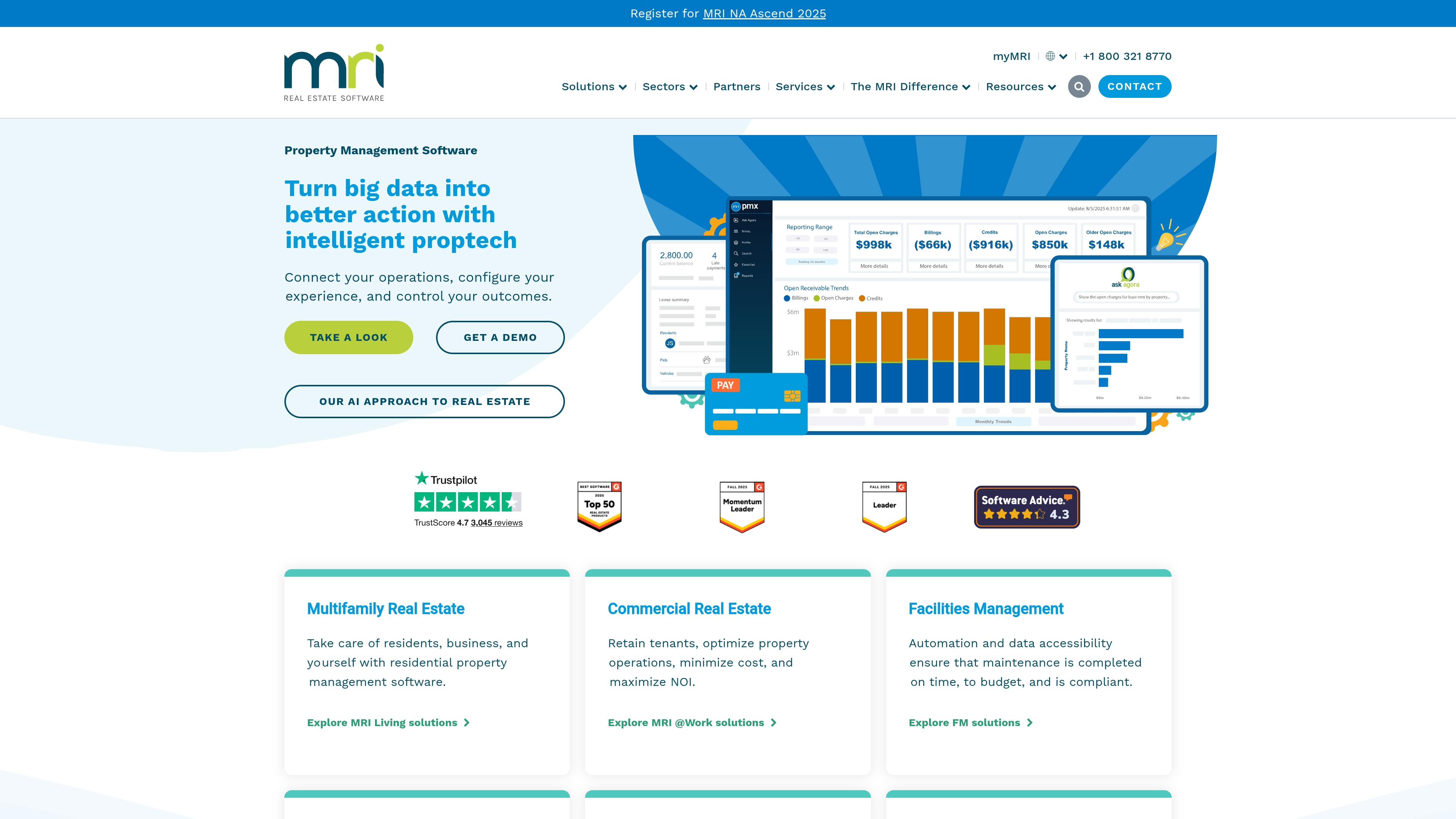
Use case:
MRI Software helps centralize facilities operations, from maintenance management to space optimization. It empowers property owners and facility managers to reduce costs, boost ROI, and create more engaging stakeholder experiences through data-driven decision-making.
Key features:
- Asset lifecycle management — Track fixed and portable assets throughout their entire lifecycle with multi-tiered registers and automated maintenance scheduling.
- Emerging AI & IoT capabilities — Explore innovative features like predictive analytics and IoT integration for proactive maintenance and real-time equipment monitoring as part of MRI’s investment in smart technology.
- Comprehensive business intelligence — Access pre-built dashboards and configurable reports that provide actionable insights into FM costs, performance metrics, and operational efficiency.
Pricing:
- Small: $60/month (monthly billing) or $634/year (annual billing)
- Medium: $170/month (monthly billing) or $1,780/year (annual billing)
- Large: $304/month (monthly billing) or $3,180/year (annual billing)
- Custom: Price on application for high-traffic locations and multi-occupier environments
- Add-ons: OnScan starts at $15/month. Desk Booking is included in the Small plan and is available as a paid add-on for Medium and Large plans.
- Each location requires its own subscription plan.
Considerations:
- The interface can be complex with a steep learning curve, which may be a challenge for new users without dedicated IT support.
- While the platform offers powerful reporting, creating custom reports can be difficult and may require specialized knowledge.
- Some users report long hold times and implementation challenges when working with customer support.
5. FMX Facility Management
FMX delivers cloud-based facilities management software that transforms how organizations handle maintenance, scheduling, and asset management. The platform specializes in user-friendly design and unlimited user access, making it particularly valuable for educational institutions and healthcare facilities with limited IT resources.
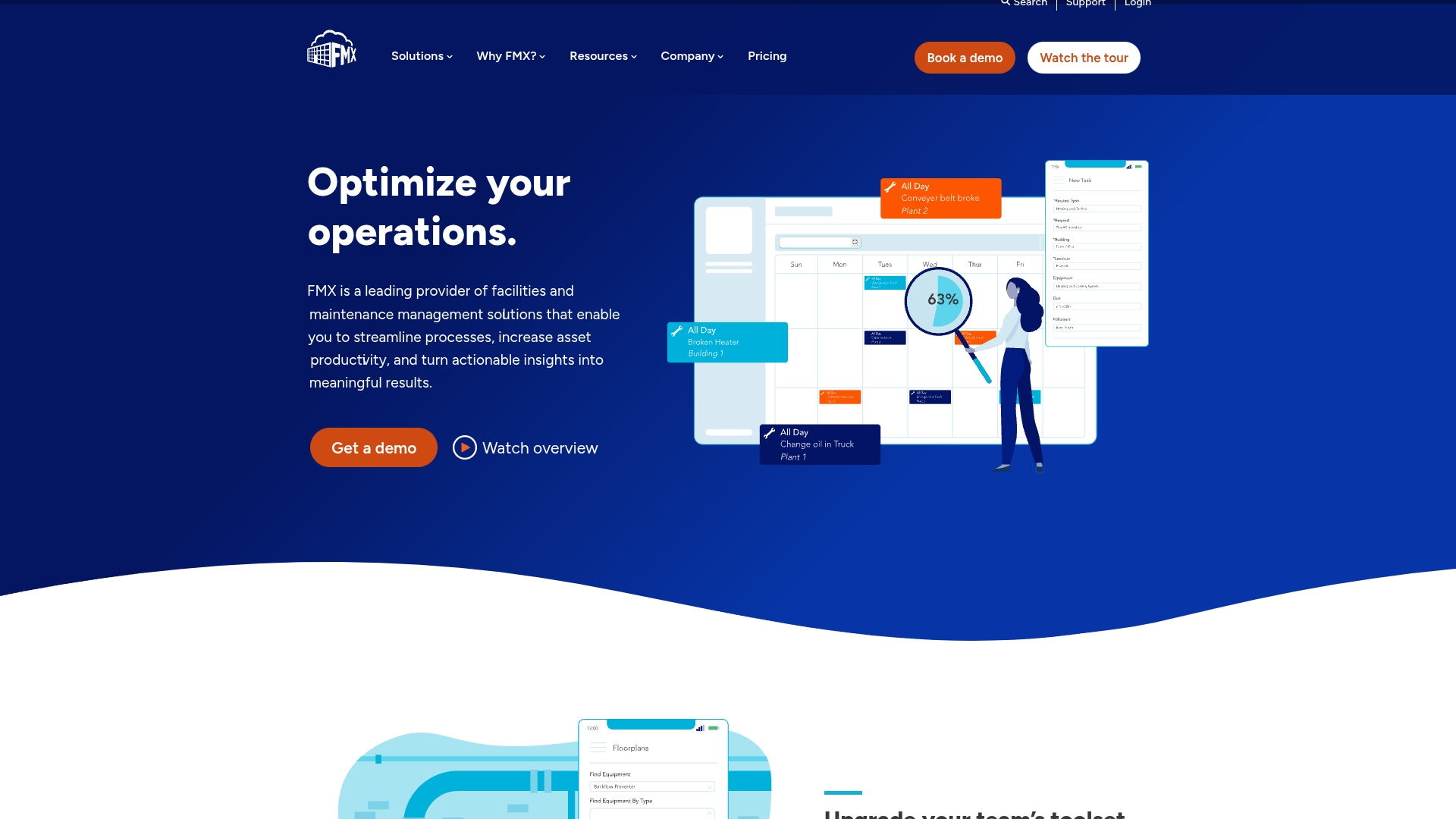
Use case:
FMX streamlines facility operations by consolidating work order management, preventive maintenance, asset tracking, and facility scheduling into one intuitive platform that requires minimal technical expertise to operate.
Key features:
- Work order management with automatic routing and approval chains for efficient task assignment and resolution
- Preventive maintenance scheduling with calendar-based interface and mobile accessibility for technicians
- Interactive floor plans and QR code asset tagging for visual facility management and quick equipment identification
Pricing:
- Custom pricing based on number of users and selected features
- K-12 schools: Special pricing based on student enrollment with unlimited users included
- Implementation fee: One-time setup cost with optional in-person training available
- Monthly payments: Available with auto-pay (potential monthly fee applies)
Considerations:
- Mobile browser experience can be clunky compared to dedicated mobile apps, limiting field technician efficiency
- Add-on features carry premium pricing that may strain budgets for smaller organizations
5 steps to a game-changing implementation
Ready to level up your service game? We’ve got your playbook right here. Rolling out a new system can feel like a huge mountain to climb, but it’s really just a series of small, manageable steps we’ll conquer together. This is how we build a service operation that not only runs smoother but that your team will actually love using.
Step 1: Get a lay of the land
First up, let’s get a clear picture of where we are today. We’ll map out your current workflows—the good, the bad, and the “we’ve-always-done-it-this-way”—to pinpoint exactly what’s working and what’s not. This gives us a solid baseline to measure our incredible progress against.
Step 2: Define your wins
Now, let’s dream a little and define what “awesome” looks like for your team. We’ll turn those dreams into clear, measurable goals, like slashing resolution times or boosting first-contact resolution. That way, we know exactly what we’re aiming for and can celebrate when we nail it.
Step 3: Give your data a fresh start
Think of this as a spring cleaning for your data. We’ll help you decide what information makes the cut, polish it up for peak performance, and move it over in smart, manageable phases. monday Service’s flexible structure makes this part surprisingly simple, setting us up with a clean, organized foundation from day one.
Step 4: Build your flow and rally the team
This is where the magic happens. We’ll use monday Service’s intuitive no-code tools to build workflows that perfectly match how your team gets things done: no more forcing square pegs into round holes. Because the platform is so visual and easy to use, training is less about lectures and more about hands-on playing, so everyone feels confident and ready to go.
Step 5: Launch, listen, and optimize
Our work isn’t done at launch. It’s just getting started. We’ll keep an eye on adoption and use real-time analytics to make smart tweaks based on how your team is actually working. This continuous feedback loop ensures your new system gets better and more valuable every single day, evolving right alongside your team.
Try monday serviceHow monday service revolutionizes facility management
Imagine a world where your facilities team isn’t constantly putting out fires.
monday Service transforms that vision into reality by uniting all your facility operations on one intelligent platform that connects with IT, HR, and every service team across your organization. Say goodbye to drowning in work orders and hello to delivering a unified service experience that actually delights everyone.
From day one, our platform becomes your team’s secret weapon. Built-in AI instantly routes requests to the perfect person and serves up smart solutions, while intuitive drag-and-drop tools empower you to craft custom workflows that match your buildings’ unique needs—zero coding required.
Finally, a system that bends to fit your processes instead of forcing you into a rigid box.
Here’s where the real magic happens: when facilities, IT, and HR unite on one platform, you unlock unprecedented visibility into how everything interconnects—from maintenance schedules to space planning and beyond. This bird’s-eye view empowers you to optimize your entire operation with the kind of confidence that turns good facility managers into strategic heroes.
FAQs about facilities management software
What is the difference between CMMS and facilities management software?
CMMS software focuses solely on maintenance, while facilities management software is a comprehensive solution that also covers space planning, vendor management, and more. A facilities management platform typically includes all the capabilities of a CMMS.
How much does facility management software cost?
Pricing varies based on the number of users, required features, and your organization's size, with costs scaling from basic plans to full enterprise solutions. The total cost depends on finding a platform that matches your specific operational needs.
Can small businesses benefit from facility management platforms?
Yes, small businesses benefit by centralizing maintenance requests, vendor management, and asset tracking in one place. Modern platforms are affordable and don't require dedicated IT resources, making them accessible for teams of any size.
What training is required for facility management software?
Modern platforms are designed with intuitive, no-code interfaces that require minimal training, allowing teams to get started quickly. Most providers also offer setup guidance and ongoing support resources to ensure a smooth adoption.
How does cloud-based facility management software ensure data security?
Cloud-based platforms secure your data with enterprise-grade measures like end-to-end encryption, regular backups, and compliance with standards such as SOC 2. These security protocols often exceed what most organizations can implement on their own.
Which industries benefit most from facilities management systems?
Industries like healthcare, education, and manufacturing see significant benefits due to complex regulatory and asset needs. However, any organization that manages physical spaces and equipment can streamline its operations with a facilities management system.
